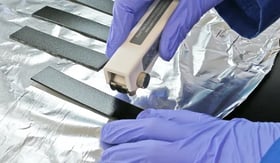At PolyCon 2025 in Milwaukee, Brighton Science unveiled a breakthrough approach to mold maintenance—one that makes invisible surface problems visible and measurable.
The session, “Invisible Problems, Measurable Solutions,” was led by Kaitlin Carroll, Customer Success.jpg?width=158&height=158&name=kaitlin-carroll-employee-photo%20(1200px).jpg) Manager at Brighton Science. With a background in chemistry and materials science, Kaitlin helps manufacturers identify and control the surface conditions that directly affect adhesion, coating, sealing, and molding outcomes.
Manager at Brighton Science. With a background in chemistry and materials science, Kaitlin helps manufacturers identify and control the surface conditions that directly affect adhesion, coating, sealing, and molding outcomes.
“Our goal was to show manufacturers how understanding and controlling surface energy can dramatically improve mold performance and product outcomes,” said Carroll. “It’s about making invisible problems visible and solvable.”
Understanding the Science of Surfaces
A surface is not the same as a material. It’s just a few molecular layers thick, and it is this atomic interface that determines how two substances interact. Those few layers are reactive, unstable, and invisible, yet they control whether a part sticks, bonds, or releases successfully.
Even minor contamination from fingerprints or airborne oils can completely alter surface behavior without any visible change.
That’s where Brighton Science’s Surface Intelligence platform comes in, providing manufacturers with visibility and control over these microscopic but critical layers.

“If you remember one thing,” Carroll noted, “remember that adhesion happens at the surface and that surface can change instantly without you ever seeing it.”
Why Surface Energy Determines Success
Surface energy describes how reactive a surface is at a given moment.
- High surface energy means the surface readily interacts with other materials, ideal for strong adhesion and coating performance.
- Low surface energy means the surface is less reactive and resists wetting, ideal for situations where easy release and non-stick behavior are desired.
However, this property is dynamic. It can change within minutes due to environmental exposure, moisture, or contamination. When that happens, product performance often fluctuates in ways that appear random but are actually predictable through measurement.
“Most manufacturers operate right at the edge of their process limits,” Carroll explained. “A small delay, temperature change, or cleaning variation can shift a surface from ‘good’ to ‘bad’ without anyone realizing it.”
The Problem with Traditional Testing
Traditional tests such as tape tests remain common, but they’re highly subjective. Results vary depending on the operator, tape type, and test conditions. This inconsistency makes it nearly impossible to ensure
repeatable surface performance across batches or teams.
Turning Measurement into Process Control
Quantifying surface conditions creates powerful opportunities for process improvement. With Brighton Science’s tools, manufacturers can:
- Reduce product sticking and mold damage
- Extend mold and tool lifespan
- Lower rework and scrap rates
- Standardize operator training and process consistency
“This takes the guesswork out of mold prep,” said Carroll. “We’re turning tribal knowledge into standardized, measurable best practices.”
Beyond Molding: Universal Applications of Surface Intelligence
While mold maintenance provides a clear example of how surface intelligence delivers measurable results, the same principles apply across nearly every manufacturing process that depends on surface performance.
From bonding and coating to sealing and cleaning, controlling surface energy is key to predictable, high-quality outcomes. Whether a manufacturer wants a surface to stick or to release, measuring and managing surface energy ensures consistent results.
Brighton Science’s solutions are trusted across a wide range of materials (metals, composites, ceramics, polymers, textiles, and glass) and industries including:
- Automotive
- Aerospace and Defense
- Chemicals and Coatings
- Consumer Products
- Industrial Equipment
“Every week I get to work on something different,” Carroll said. “It’s incredible to see how universal this science is and how much impact it has once people can measure what’s really happening on their surfaces.”
Ready to Improve Your Mold Maintenance Process?
If you’re ready to turn invisible surface challenges into measurable results, Brighton Science can help.
Our team partners with manufacturers to implement data-driven surface intelligence that improves process reliability, extends tool life, and enhances product quality.
Contact us today to schedule a consultation or demo and discover how to bring surface intelligence to your production floor.


